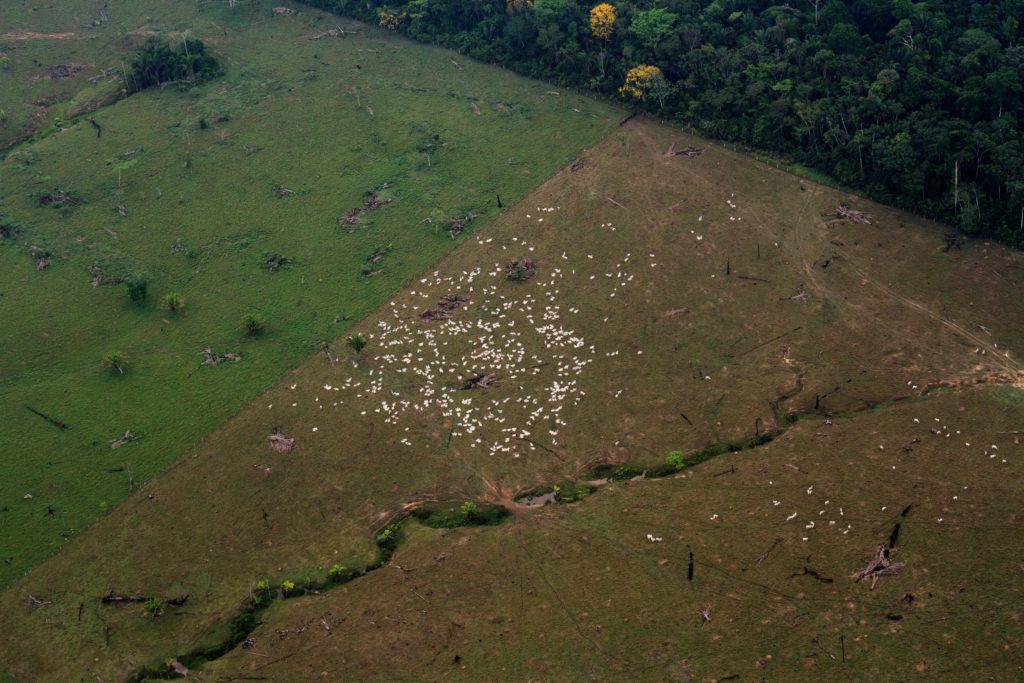Organized Crime Is a Top Driver of Global Deforestation–along with Beef, Soy, Palm Oil and Wood Products
ENVIRONMENT, 22 Nov 2021
Jennifer Devine | The Conversation – TRANSCEND Media Service
15 Nov 2021 – Every year the world loses an estimated 25 million acres (10 million hectares) of forest, an area larger than the state of Indiana. Nearly all of it is in the tropics.
Tropical forests store enormous quantities of carbon and are home to at least two-thirds of the world’s living species, so deforestation has disastrous consequences for climate change and conservation. Trees absorb carbon dioxide as they grow, slowing its buildup in the atmosphere – but when they are burned or logged, they release their stored carbon, fueling further warming. Tropical forest loss generates nearly 50% more greenhouse gases than does the global transportation sector.
At the 2021 U.N. conference on climate change in Glasgow, more than 100 world leaders pledged on Nov. 1 to halt deforestation by 2030. In the Declaration on Forests and Land Use, countries outlined their strategy, which focuses on supporting trade and development policies that promote sustainable production and consumption. Governments and private companies have pledged over US$19.2 billion to support these efforts.
From my research on social and environmental issues in Latin America, I know that four consumer goods are responsible for the majority of global deforestation: beef, soy, palm oil, and wood pulp and paper products. Together these commodities are responsible for the loss of nearly 12 million acres (5 million hectares) annually. There’s also a fifth, less publicized key driver: organized crime, including illegal drug trafficking.
TO CONTINUE READING Go to Original – theconversation.com
____________________________________________
– Associate Professor of Geography and Environmental Studies, Texas State University
Tags: Amazonia, BRICS, Bolsonaro, Brazil, CO2, Carbon source, Cattle and Ranch Farmers, Climate Change, Corruption, Deforestation, Environment, Forest fires, Global warming, Greenpeace, Human Rights, Indigenous Rights, JBS, Latin America Caribbean, Meat Industry, Nature's Rights, Rain Forests, Resources, Violent conflict
DISCLAIMER: The statements, views and opinions expressed in pieces republished here are solely those of the authors and do not necessarily represent those of TMS. In accordance with title 17 U.S.C. section 107, this material is distributed without profit to those who have expressed a prior interest in receiving the included information for research and educational purposes. TMS has no affiliation whatsoever with the originator of this article nor is TMS endorsed or sponsored by the originator. “GO TO ORIGINAL” links are provided as a convenience to our readers and allow for verification of authenticity. However, as originating pages are often updated by their originating host sites, the versions posted may not match the versions our readers view when clicking the “GO TO ORIGINAL” links. This site contains copyrighted material the use of which has not always been specifically authorized by the copyright owner. We are making such material available in our efforts to advance understanding of environmental, political, human rights, economic, democracy, scientific, and social justice issues, etc. We believe this constitutes a ‘fair use’ of any such copyrighted material as provided for in section 107 of the US Copyright Law. In accordance with Title 17 U.S.C. Section 107, the material on this site is distributed without profit to those who have expressed a prior interest in receiving the included information for research and educational purposes. For more information go to: http://www.law.cornell.edu/uscode/17/107.shtml. If you wish to use copyrighted material from this site for purposes of your own that go beyond ‘fair use’, you must obtain permission from the copyright owner.

